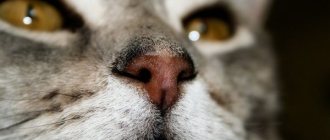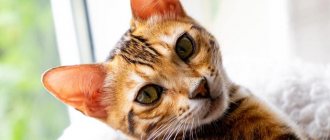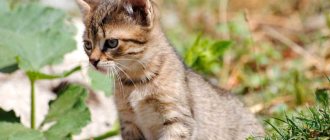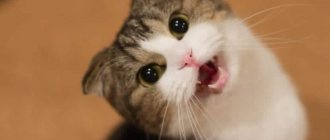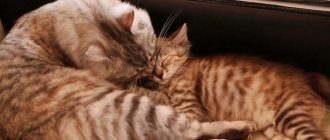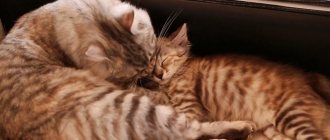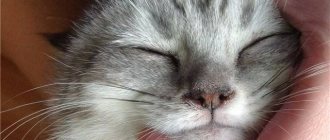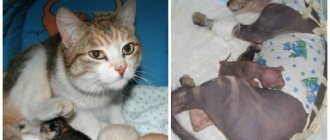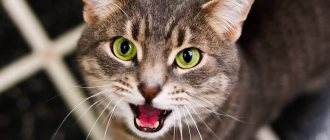What kind of nose should a healthy pet have?
Many owners are concerned with the question of what a healthy kitten’s nose should be like. First of all, a healthy nose is a moist and cool nose that glides a little. This is due to the nature of the animal. In fact, cats are predators for whom the nose is the main assistant in the hunt. The wet organ helps determine where the wind is blowing - this is necessary so that the victim does not smell the cat's scent. This is why having a wet nose is important.
When determining the health of a pet, it is necessary to take into account the type of activity of the kitten. If he has just woken up or was engaged in active play, then he may experience a dry nose. This is due to the fact that pets have a higher body temperature than their owners, and therefore moisture evaporation occurs more intensely. Physiological causes of dryness are:
- dream;
- awakening;
- active games;
- hot room;
- sharp fear;
- prolonged exposure to the sun;
- sedentary lifestyle.
Pathological causes that can be dealt with at home
Excessive carelessness is much more dangerous than excessive vigilance, so it is better to once again seek help from veterinarians than to miss a serious pathology. But in some cases, the problem can be solved at home; it is only important to correctly determine the cause of the deviation. To do this, you need to pay close attention to the accompanying symptoms.
Sunburn
An increase in the temperature of the lobe is an absolutely normal consequence of an animal walking under the scorching sun. But if the cat's nose becomes not just hot, but also red and flaky, then it is likely that it is a sunburn. Animals with pink noses are especially sensitive to sunlight.
To eliminate the burn, you can use natural vegetable oil. If your pet reacts too aggressively to touching its face, you can apply Vaseline or Panthenol to its nose (in this case you will have to hold the pet’s mouth for 5-6 minutes). But if the problem recurs again and again, you will still have to contact a veterinarian. Otherwise, skin cancer may develop.
Contact allergy
A cat's hot nose may be a sign of a mild allergic reaction. Associated symptoms:
- a sharp change in the pigmentation of the lobe (redness);
- sneezing;
- the appearance of a rash on the face.
This type of allergy usually occurs when unprotected nasal tissue comes into direct contact with chemicals and dyes. But cats especially often react negatively to dishes made of low-quality plastic.
First of all, you need to exclude your pet from contact with a potential allergen; Replace all plastic utensils with ceramic or glass ones. Apply a cool compress to the face, and if the symptoms are too painful, then Suprastin can be used.
What are the signs that require contacting a veterinarian?
If the following symptoms are detected in a kitten, you should consult a veterinarian to identify the causes of your pet’s illness:
- malaise, lethargy, apathy;
- dry and hot nose;
- cold and pale nose;
- change in organ color (blue, yellowish, red, white).
The owner should know that a pale and cold organ in a kitten is a sign of:
- chronic illness;
- hypothermia;
- stress;
- low body temperature;
- poisoning;
- complete lack of appetite.
A white and warm nose is a sign of a disruption in the kitten’s circulatory system. The blue and hot organ talks about:
- heart failure;
- inflammation of the respiratory organs;
- oxygen starvation.
When a kitten has a hot and red organ, this is a sign:
- infectious disease;
- rhinitis;
- mechanical damage.
If a kitten has a hot, dry nose and warm ears, then this is not necessarily a sign of illness, because heat exchange has not yet been established in babies, and their body temperature is higher than that of an adult pet. This may be due to the work of the body and its protection from hypothermia.
How can I help my pet?
What to do if your cat has a dry nose? Of all the possible reasons for which the olfactory organ is hot and dry, owners of mustachioed pets can only try to normalize the body temperature, because... with this symptom it is most often increased. It is better not to engage in self-diagnosis and self-medication, because... There are many different reasons for this condition; it is almost impossible for a non-specialist to determine the exact cause! Measuring the temperature is the first and most important thing that a pet owner should do when they notice a long-term warm and dry nose.
It is strongly recommended not to treat fever in cats (up to 40C) with medications. Three main points for reducing body temperature without medication: give the cat cool (not cold!) water, wet the fur, and apply something cold to the groin and armpits. Any other assistance should already be provided by a veterinarian after an accurate diagnosis has been established.
What signs will help determine the onset of the disease?
In addition to the signs listed above, the kitten also exhibits other symptoms indicating the onset of the disease. These include:
- increasing or decreasing the number of trips to the toilet;
- diarrhea or bloody stools;
- vomit;
- increased anxiety of the animal;
- hair loss;
- increased thirst;
- cardiopalmus;
- deep breathing;
- nasal discharge.
If you have these symptoms, you should consult a specialist; only he can make a correct diagnosis and prescribe treatment. You should not self-medicate, as this will only worsen the situation.
Often a kitten's dry nose is an indicator of intestinal problems, namely the presence of hair in the gastrointestinal tract. This is the only indicator of this problem.
Primary atrophic rhinosinusitis
Primary atrophic rhinosinusitis is more often diagnosed in patients from low socioeconomic status groups living in geographic areas with warm climates. Areas of high prevalence include southern Saudi Arabia, China, Africa, India, the Mediterranean and the Philippines.
Atrophic rhinosinusitis is more common in women. It is diagnosed more often at young ages than at older ages.
Clinical picture
Patients experience a constant sensation of an unpleasant odor in the nose (this disorder of smell is called cacosmia). At the same time, there is also an unpleasant odor from the mouth, noticeable to others. This is where the term “ozena” (“stench”) comes from, which is sometimes used as a synonym for severe primary atrophic rhinosinusitis.
Other symptoms include lack of sense of smell (anosmia), nosebleeds, nasal pain, sleep disturbances, and suffocation due to excessive crusting.
Patients complain of nasal congestion even with excessively wide nasal passages, which is better characterized by the concept of “lack of sensation of breathing.” Nasal congestion occurs due to improper passage of air through the nasal cavity, lack of resistance and sensation of air flow due to loss of tissue containing sensory receptors. The same phenomenon is observed in patients with perforation of the nasal septum.
The disease is characterized by the replacement of normal pseudostratified columnar epithelium with squamous epithelium. This tissue lacks cilia and mucus-producing goblet cells.
The most common culprits of the bacterial process in the nose are Klebsiella ozaenae, Proteus, Escherichia coli, Staphylococcus aureus, Streptococcus pneumoniae.
ENT examination
During rhinoscopy (examination of the nose), the doctor sees a shiny, thin, pale, and sometimes ulcerated mucous membrane, covered with thick yellow, brown or green crusts, sometimes bloody, covered with a purulent coating. Resorption (destruction) of the underlying cartilage and bone leads to an increase in the volume of the nasal cavity. Some patients are diagnosed with perforation of the nasal septum and secondary saddle deformation of the external nose (recession of the nasal dorsum).
Predisposing factors to the development of primary atrophic rhinosinusitis are completely unknown. It is discussed that these could be endocrine, vascular, infectious and autoimmune diseases, as well as occupational hazards (working in dusty, contaminated areas with chemical or industrial dust).
Computed tomography of the nose and paranasal sinuses
Possible finds include:
- atrophy of the mucous membrane of the lower and middle turbinates and bone resorption;
- resorption of cells of the ethmoidal and uncinate labyrinth;
- an increase in the volume of the nasal cavity with destruction of its lateral walls;
- thickening of the mucous membrane of the paranasal sinuses;
- hypoplasia (reduction) of the maxillary sinuses with a decrease in their pneumatization (airiness).
What should the owner do to help the cat?
The first thing the owner needs to do if he discovers a dry nose in a cat is to observe its general condition. Maybe she had a fever. Hot ears confirm the presence of a high temperature. It would be useful to take your temperature several times a day; this should be done rectally. Readings up to 37-38 degrees are considered normal; if it rises above 38.5, then you need to contact a veterinarian. When a kitten’s temperature reaches too high, you can help him with the following manipulations:
- wet the kitten’s fur with water from time to time;
- place a cold pack under the neck or on the inner thigh;
- provide access to clean and fresh water.
Only a veterinarian can determine why the temperature has risen, and only he can give advice on the choice of antipyretic drugs.
Now you know why a cat has a dry nose. There can be many reasons for this, and they are not always signs of illness. If they coincide with a dry nose, then you should not wait for the kitten’s well-being to improve on its own and it is better not to postpone a visit to the veterinarian.
When a dry nose should alert you
If the nasal planum has dried out, and this symptom is accompanied by other manifestations, then you need to pay special attention to these symptom complexes. A hot nose in a cat should alert you if this fact has been observed for a long time (for example, it is constantly dry throughout the day).
The following accompanying symptoms should attract attention:
- the cat/cat is lethargic, apathetic, practically does not eat anything, does not want to play;
- Thirst may occur (due to dehydration, secretion ceases to be produced, which makes the nose wet);
- sleep a lot and for a long time (it seems that the animal sleeps around the clock);
- along with a hot nose, the cat has noticeably hot ears (usually this is a sign of elevated temperature);
- rapid shallow breathing (normal is from 16 (18) to 33 respiratory movements per minute) or accelerated heartbeat (normal pulse is 100-120 beats/min in adults, up to 140 beats/min in kittens);
- on the contrary, slow and deep breathing;
- nasal discharge of any kind and sneezing;
- any changes in color (blue, yellowish, intense red or white, almost discolored).
If a warm and dry nose is accompanied by the following signs, then this is already a reason for a mandatory visit to the veterinarian (especially if the signs are pronounced):
- there are changes in the frequency of visiting the toilet, and it does not matter whether it is more frequent or, conversely, less frequent (on average 1-2 (3) times a day defecation, 2-3 times a day urination);
- change in the condition of feces - usually towards diarrhea (especially if with bloody impurities);
- nausea (the cat begins to lick itself frequently, because at the moment of nausea the secretion of saliva increases) or obvious vomiting is observed;
- the fluid secreted from the nostrils is opaque, with an unpleasant odor;
- body temperature rose to 40C.
Natural causes of baby's dry nose
As already mentioned, this condition is not always a cause for concern. It is worth highlighting a number of natural reasons that can lead to such changes.
Animal's recent sleep
Animals almost always have a dry nose after waking up. This is due to the fact that the kitten does not lick itself while sleeping, the secretion is not produced, and the lobe is not moistened.
After a short period, the organ becomes cool and moist again. There is no reason to worry in this case.
High indoor or outdoor temperature
Dryness is often observed during hot weather, with a lack of fresh air.
For example, if a kitten rested in the sun or a radiator, its nose will inevitably heat up. After a while, everything returns to normal on its own.
Stress in an animal
Insufficient moisture in the earlobe is often caused by stress.
The following seemingly minor factors can lead to such changes:
absence of the owner for a long time;- strangers coming to the house;
- the appearance of a new animal in the apartment;
- moving;
- visiting a veterinary clinic;
- carrying out hygiene procedures.
After an active game
If a cat has been jumping, running, or playing for a long time, its nose dries out due to a natural increase in body temperature. When he rests, everything will return to normal.
Old age of the animal
At an early and old age, cats experience a disturbance in the process of thermoregulation.
Accordingly, the mirror may become dry. Such changes also do not cause concern. They are considered a variant of the norm.
Cat nose, basic functions
A cat's nose is a kind of indicator of the health and physiological state of furry pets. The olfactory organ in cats, like in humans, has a complex structure. The nose is necessary for the adaptation of animals to the environment; it allows representatives of the cat family to navigate in space and determine the temperature of food.
With the help of the cat's nose, the cat perceives third-party odors . At the same time, taking into account the hunting instinct inherent in nature, thanks to an acute sense of smell, cats can determine the location of their “prey”. In some cases, the nose allows furry pets to navigate their surroundings. In addition, a kitten's sense of smell is several times better than a person's sense of smell.
© shutterstock
